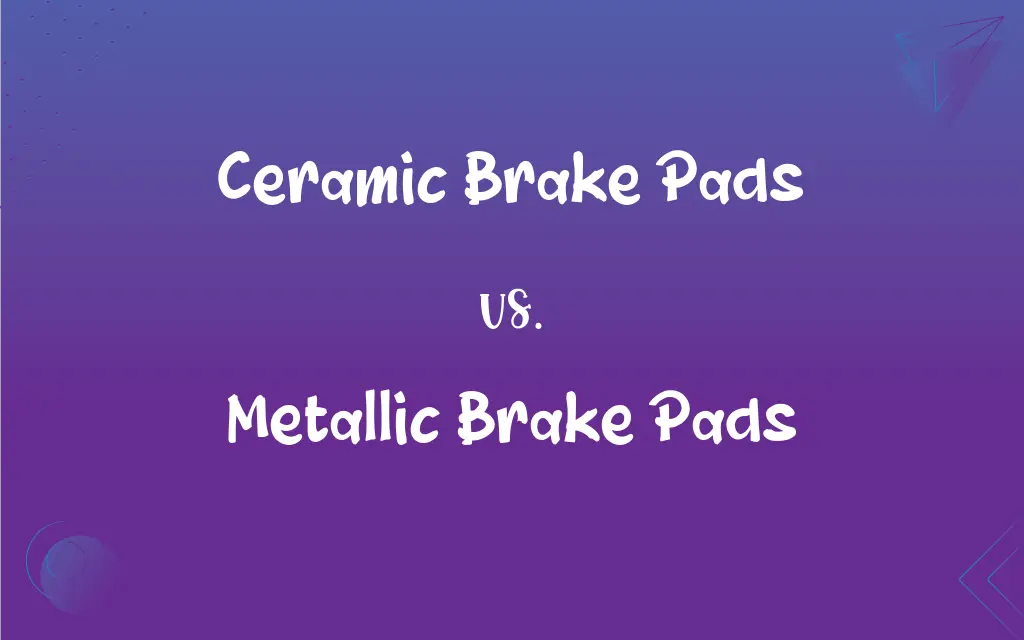Ceramic Brake Pads vs. Metallic Brake Pads: What's the Difference?
Edited by Aimie Carlson || By Janet White || Published on August 28, 2024
Ceramic brake pads offer quieter operation and less wear on brake rotors than metallic pads, which provide better heat dissipation and performance but are noisier and more abrasive.

Key Differences
Ceramic brake pads and metallic brake pads serve the same fundamental purpose in a vehicle's braking system but do so using different materials and technologies. Ceramic brake pads are made from dense ceramic material mixed with copper fibers, offering a quieter braking experience and generating less brake dust than their metallic counterparts. Metallic brake pads, composed of metals like steel, copper, and iron, excel in heat dissipation and provide superior braking performance, especially under extreme conditions.
The difference in composition between ceramic and metallic brake pads leads to distinct advantages and disadvantages for each type. Ceramic pads, being gentler on brake rotors, tend to last longer and preserve the condition of the rotors over time. However, they might not perform as well in very cold temperatures or under the intense demands of racing or heavy towing. Metallic pads, on the other hand, offer consistent performance across a wide range of temperatures and driving conditions but can accelerate rotor wear due to their abrasive nature.
When it comes to cost, ceramic brake pads typically come at a higher price point due to their longevity and the benefits of quieter operation and reduced brake dust. Metallic pads, being less expensive to produce, offer a cost-effective option for drivers who prioritize performance and are willing to deal with increased noise and dust.
Drivers must consider their vehicle type, driving habits, and performance needs when choosing between ceramic and metallic brake pads. Ceramic pads are ideal for everyday driving in passenger vehicles where comfort and minimal maintenance are key. In contrast, metallic pads are suited for high-performance vehicles, severe duty applications, and environments where temperature extremes are common.
The choice between ceramic and metallic brake pads depends on a driver's priorities: whether they value the quiet, clean operation and reduced wear on rotors offered by ceramic pads, or the superior performance and cost savings provided by metallic pads. Each type has its place in the automotive world, catering to different segments of drivers with varying needs and expectations.
ADVERTISEMENT
Comparison Chart
Composition
Made of dense ceramic material and copper fibers.
Composed of metals like steel, copper, and iron.
Performance
Quieter operation, less effective in extreme cold.
Superior performance in wide temperature ranges.
Wear on Rotors
Less abrasive, gentler on rotors.
More abrasive, may accelerate rotor wear.
Dust Production
Produce less brake dust.
Tend to produce more brake dust.
Cost
Generally more expensive due to longevity and benefits.
Less expensive, cost-effective for performance driving.
ADVERTISEMENT
Ceramic Brake Pads and Metallic Brake Pads Definitions
Ceramic Brake Pads
Ceramic brake pads are less abrasive on brake rotors.
Choosing ceramic brake pads has extended the life of my car's brake rotors.
Metallic Brake Pads
Metallic brake pads are a cost-effective option for high-performance vehicles.
Opting for metallic brake pads was a budget-friendly choice for my racing setup.
Ceramic Brake Pads
Ceramic brake pads are suitable for everyday driving and luxury vehicles.
For my luxury sedan, I prefer the quiet operation of ceramic brake pads.
Metallic Brake Pads
Metallic brake pads excel in heavy-duty and performance driving.
For towing and heavy loads, I rely on metallic brake pads for their superior stopping power.
Ceramic Brake Pads
Ceramic brake pads are made from a mixture of ceramic and copper fibers.
Ceramic brake pads use advanced materials for improved longevity.
Metallic Brake Pads
Metallic brake pads provide excellent performance and heat dissipation.
My sports car's metallic brake pads handle high-speed braking effortlessly.
Ceramic Brake Pads
Ceramic brake pads offer quieter braking with minimal dust.
After switching to ceramic brake pads, I noticed significantly less dust on my wheels.
Metallic Brake Pads
Metallic brake pads may produce more noise and brake dust.
Despite the increased noise, I prefer metallic brake pads for their performance.
Ceramic Brake Pads
Ceramic brake pads perform optimally in a range of driving conditions.
My ceramic brake pads provide smooth braking in both city traffic and highway driving.
Metallic Brake Pads
Metallic brake pads are composed of a blend of metals.
The high metal content in metallic brake pads offers great durability.
FAQs
What is the lifespan of ceramic brake pads?
Ceramic pads generally last longer than metallic pads, but their lifespan can vary depending on driving habits and conditions.
Are ceramic brake pads better than metallic?
They are quieter and cleaner but may not perform as well in high-performance or heavy-duty applications compared to metallic pads.
Do ceramic brake pads wear rotors faster?
No, ceramic brake pads typically cause less wear on rotors compared to metallic pads.
How do ceramic brake pads perform?
They offer smooth and consistent braking, with less noise and dust compared to metallic pads. However, their performance in extreme cold or racing conditions might be less optimal.
Are ceramic brake pads environmentally friendly?
Yes, they produce less brake dust and harmful particles, making them more environmentally friendly than some alternatives.
What are ceramic brake pads?
Ceramic brake pads are made from a blend of ceramic fibers, nonferrous filler materials, and sometimes small amounts of metal. They are known for quiet operation and low dust production.
What are metallic brake pads?
Metallic brake pads are made from a mixture of metals and fillers, providing strong braking performance and heat dissipation.
How do metallic brake pads perform?
They offer excellent performance in a wide range of temperatures and conditions, especially in high-performance and heavy-duty applications.
Do metallic brake pads wear rotors faster?
They can cause more wear on rotors than ceramic pads due to their abrasive materials.
What are the disadvantages of metallic brake pads?
Increased noise, more brake dust, and potential for more rotor wear compared to ceramic pads.
Are ceramic brake pads expensive?
Yes, they tend to be more expensive upfront than metallic pads but can offer longer life and less rotor wear.
What are the disadvantages of ceramic brake pads?
They are not as effective in extreme temperatures or heavy-duty applications and are more expensive than metallic pads.
How do I know if metallic brake pads are right for my car?
If you prioritize performance in high-temperature conditions or have a high-performance or heavy-duty vehicle, metallic pads may be suitable.
Can ceramic brake pads be used in any vehicle?
While they can be used in many vehicles, they are best suited for passenger cars and light trucks, not high-performance or heavy-duty vehicles.
Are metallic brake pads noisy?
They can be noisier than ceramic pads and may produce more brake dust.
What is the lifespan of metallic brake pads?
Metallic pads typically have a shorter lifespan than ceramic pads, depending on usage and driving conditions.
Are metallic brake pads cheaper than ceramic?
Yes, they are generally less expensive upfront than ceramic pads.
Can metallic brake pads be used in any vehicle?
They are versatile but best suited for vehicles requiring high-performance braking, like sports cars and heavy-duty trucks.
How do I know if ceramic brake pads are right for my car?
Consider your driving conditions, performance needs, and whether you prioritize quiet operation and cleanliness over high-temperature performance.
What are the advantages of metallic brake pads?
They provide strong braking power in a wide range of conditions and are cost-effective for high-performance use.
About Author
Written by
Janet WhiteJanet White has been an esteemed writer and blogger for Difference Wiki. Holding a Master's degree in Science and Medical Journalism from the prestigious Boston University, she has consistently demonstrated her expertise and passion for her field. When she's not immersed in her work, Janet relishes her time exercising, delving into a good book, and cherishing moments with friends and family.
Edited by
Aimie CarlsonAimie Carlson, holding a master's degree in English literature, is a fervent English language enthusiast. She lends her writing talents to Difference Wiki, a prominent website that specializes in comparisons, offering readers insightful analyses that both captivate and inform.






































































